
Publisher:
Bonnie King
CONTACT:
Newsroom@Salem-news.com
Advertising:
Adsales@Salem-news.com

~Truth~
~Justice~
~Peace~
TJP
Feb-06-2014 11:51

 TweetFollow @OregonNews
TweetFollow @OregonNews
SPECIAL FEATURE: The Bare Naked Face of Capitalism: Goldman Prizewinner Gets 21 Years for Resistance to Genocide
Keith Harmon Snow for Salem-News.comForeign mining, state corruption & Genocide in Mongolia.
 Herder nomads in west central Mongolia. Photo c. keith harmon snow, 2008. |
(WILLIAMSBURG, MA) - Packed with distortions and outright lies, Mongolia's privatized former state media called them the 'enemies of Mongolia'. On 16 September 2013, the leaders of Mongolia's Fire Nation (Gal Undesten in Mongolian), an environment and human rights coalition, organized a mass protest in front of the Mongolian Parliament. Decades of grassroots organizing to establish environmental protections were at risk: on September 16 the Great State Khural (State Parliament) gathered with intentions to dismantle the so-called 'Law With A Long Name' (LLN).
Adopted by parliament in 2009, after more than a decade of grassroots organizing and public pressure, the 'Law to Prohibit Mineral Exploration and Mining Operations at the Headwaters of Rivers, Protected Zones of Water Reservoirs and Forested Areas' is the only significant Mongolian law protecting nomadic herders' traditional lands and watersheds from further radioactive and chemical contamination, diversions of rivers and land-grabbing. With mining companies ignoring the law, destroying pastureland and watersheds, and no government enforcement, the livelihoods and culture of indigenous Mongolian herders are rapidly disappearing. These are the same mining corporations responsible for genocide and crimes against humanity in Africa and Latin America and everywhere we find them.
Symbolically armed with hunting rifles and antiquated weapons, the most courageous leaders of the grassroots Fire Nation sought to draw attention to corruption and collusion between government and foreign mining corporations. They are fighting to save their culture and people and their very way of life.
In a statement read on the steps of Parliament prior to the arrests, Ts. Munkhbayar called for urgent and serious action to protect the Law with a Long Name (LLN). The People began with cooperative meetings, he said, engaging government officials and agencies, and the People won the passage of the Law with a Long Name, but there was no enforcement, and corporations were getting away with egregious wrongs. So then the People came with petitions. When petitions didn't work they threw rocks at Parliament. Then they fired their rifles on machines that were ripping up their precious pasturelands. They symbolically shot arrows at Parliament from their herder's bows. Nothing moved the government to protect the People and the land. Now they had come with weapons. They never intended to hurt anyone, and they never hurt anyone.
These are herders who employ a wide range of methods and tactics, including environmental education, public theater, monitoring of pollution, restoration of ecosystems, alliances with government, campaigns in the legislature. They have also fired on foreign mining equipment and occupied illegal mining sites. Many of their actions have been symbolic, born out of integrity and the spirit of civil disobedience.
"On the morning of September 16, delegates representing 11 non-government organizations protested outside the Government Palace against proposed amendments to the [LLN]," wrote M. Zoljargal for Rivers Without Boundaries, a coalition of NGOs working to protect Eurasian watersheds. "The reason for the protest was to prevent the approval of the amendment, as the 2009 law hasn't been implemented or enforced in its current form. Many protected lands have been mined despite the law meant to preserve the integrity of Mongolia's environment. The protestors were there to stop the amendment, fearing that once the law is amended, permit termination and state protection might become impossible." [1]
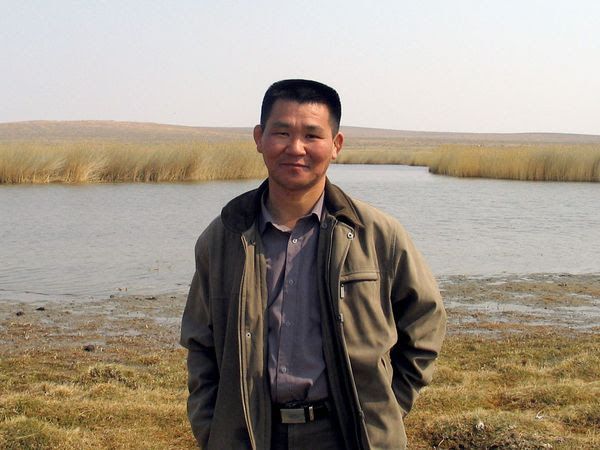 Photo of Tsetsegee Mounkhbayar taken by Bill Infante of the Asia Foundation. |
Mongolian civil society leaders declare that state agents framed Munkhbayar and the other protestors. Four of the ten protestors arrested on 16 September 2013 were released; six were detained on the charge "group attempt to severely threaten well-being of society". Defense lawyers argued that there was no victim in the case but they were prohibited from mounting a substantial defense. Many key facts were ignored and evidence was suppressed and sidelined. There is substantial evidence that Mongolian government agents used 'dirty tricks' typical of thugs, terrorist organizations and state security agents (e.g. C.I.A., Stasi, MI-6, SAVAK, F.B.I., etc.), dirty tricks and thuggery which bears the signature of the Mongolian state security apparatus.
On 21 January 2014, the six civil society leaders were sentenced to prison. Defendants J. Ganbold, G. Boldbaatar, D. Tumurbaatar, S. Dashtseren and Ts. Munkhbayar received 21 years and six months (reduced from 22 years and six months for time served since 16 September 2013). The sixth man, M. Munkhbold was sentenced to two years for supplying weapons. When the verdict and sentences were delivered in court, the wife of J. Ganbold (suffering from ovarian cancer) fainted; others shouted and cried.
The six men, all 50-60 years of age, were interrogated under harsh conditions in state detention cells. One of the six, J. Ganbold, is reportedly in danger of losing his hand after police removed a cast and refused him medical treatment. When Mr. Ganbold's wife pled with the court for her husband to receive treatment, the chief investigator derided her, declaring that her husband and the others deserved to suffer, implying they are traitors of the state.
Most of these leaders have previously been arrested in the long struggle to defend Mongolia from the hydra of Western industries of exploitation: mining, 'development', 'nature conservation', and foreign 'aid' and 'charity'.
HIS NAME IS MUNKHBAYAR AND HE IS NO TERRORIST
In early September 2010, a small band of citizens fired their hunting rifles on gold mining equipment owned by two foreign mining firms operating illegally in northern Mongolia. The gang of four -- Ts. Munkhbayar, G. Bayaraa, D. Tumurbaatar and O. Sambuu-Yondon -- all hailed from the United Movement of Mongolian Rivers and Lakes (UMMRL), a consortium of Mongolian groups organized to fight extractive companies that have invaded the fledgling 'democracy'.
A key leader and long-time organizer of the Mongolian resistance movement, Ts. Munkhbayar is a 2007 winner of the prestigious Goldman Environmental Prize -- the 'Green Nobel' -- awarded annually to people taking fearless stands around the globe in defense of the earth and it's indigenous peoples. Three years after winning the award -- and a whole lot more illegal mining and pollution later -- Munkhbayar's little gang of four and their militant actions against the capitalist invasion remained in complete media whiteout in the Western press.
UMMRL was formed in 2009 after its predecessor, the Mongolian Nature Protection Coalition (MNPC), dissolved. Tsetsegee Munkhbayar and his colleagues were pivotal to the creation of both MNPC and UMMRL, and on 2 July 2010 they founded the Fire Nation, a large umbrella organization uniting many NGOs.
After winning the Goldman prize, activist Ts. Munkhbayar was widely celebrated by Western institutions and the English-speaking press for his peaceful and collaborative achievements in uniting nomads and organizing people and protecting Mongolia's environment. He was a national hero, standing up for ordinary people and basic human rights, a former herder turned national spokesman who rose out of the backward and repressive social milieu of communism in collapse. Munkhbayar was rewarded for speaking up -- an action unheard of in Mongolian society -- in the former Soviet-run communist republic turned 'emerging democracy'.
Increasingly frustrated by a stodgy bureaucracy and massive state corruption, betrayed by Western conservation and development organizations, faced with mounting losses and accelerated destruction of their culture and environment, Ts. Munkhbayar and comrades became increasing aggressive in organizing resistance.
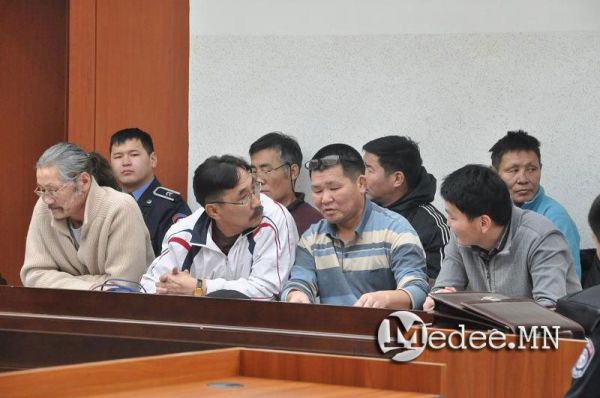 The six environmental leaders accepted their sentences in court with dignity and calm. |
The more they stood up for the rights of Mongolia and its people, the more they were shunned or ignored by their former sponsors. For Ts. Munkhbayar, this meant that the Goldman Fund distanced themselves from him, and the Asia Foundation, whose officials had lobbied the Goldman Fund on his behalf, labeled him a 'terrorist'. [2]
In June 2011 Ts. Munkhbayar and colleagues were imprisoned for 'organizing public meetings and demonstrations without official permission'. The men went on hunger strikes in prison: some were taken to hospital and force fed by the security agents after their health acutely deteriorated.
THE GREEN TERROR
"In August 2013, pressure from foreign mining companies to relax regulations reached an all-time high and rumors emerged that Parliament was seeking to abolish the LLN once and for all," reads a Goldman Foundation statement of 20 November 2013, calling for a 'fair and transparent trial' for Munkhbayar and the others. "That same day, Munkhbayar and UMMRL joined several other activist groups in a demonstration outside the main Parliament building. During the protest, a rifle was accidentally discharged. It is widely understood that the shot was not fired on purpose and nobody was injured. Still, Munkhbayar and several other protestors were arrested immediately following the incident."
The Goldman Foundation statement is inaccurate. A simple viewing of a video of the 16 September 2013 incident shows that the Mongolian state security had already tackled Ts. Munkhbayar and several other protestors when the shot rang out nearby. The protestors had not tried to enter the government building, either peaceably or forcibly. State agents and the video cameraperson then directed their attention to another struggle between state agents and another of the protestors, presumably one who accidentally discharged his rifle.
The protestors are accused of firing a single shot from one of their weapons. In the confusion of what happened, it is not clear who fired a shot. The herders claim the discharge was accidental, and if it came from their weapon, it certainly was an accident. The court did not sufficiently investigate the facts. However, there is ample evidence that it was a state security agent who discharged a weapon. As the video reveals, Munkhbayar was not guilty of firing off weaponry, but the courts didn't care to argue such fine points.
Ten protestors were arrested on 16 September 2013. State agents evacuated several government buildings claiming that bombs had been planted. Explosives shown in Mongolian mass media campaigns to discredit the protestors were reportedly recovered in buildings where the protestors could not have had access. The mass media claimed that protestor's guns were loaded and they were heavily armed. Reports also claimed that the protestors "attacked the government buildings and fired a shot."
There are many other curious discrepancies and outright fabrications.
One Mongolian business media outlet declared that 'shots' [plural] were fired, 'a bomb was discovered', and 'a hand-grenade was thrown which didn't explode'. [3]
In a statement made immediately after the arrests, the head of Mongolia's General Intelligence Agency investigations department claimed that the protestors "attempted to threaten public security and assault some state officials." He also declared that "[a]s a result of prompt searches [security and intelligence officials] searched and found two TNT (trotyl) [sic] hand-made bombs planted near government buildings. [4]
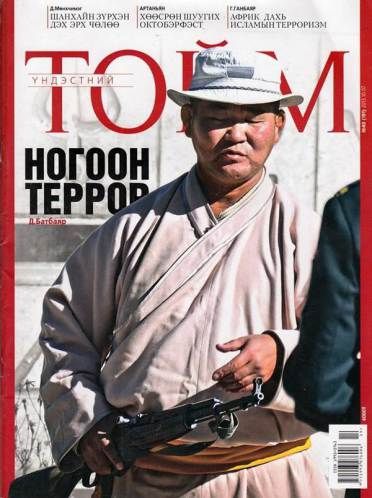 |
After the September 16 protest, the media accused the protestors of 'organizing a public event without permission' and 'mass murder attempt' and even 'attempted genocide'. Mongolia's National Overview magazine, a copycat of Time (Yndestnii Toim in the Mongolian language rhymes with Time) featured Goldman prizewinner Ts. Munkhbayar on the cover, an old Russian rifle in hand, under the headlines: 'НОГООН ТЕРРОР' -- GREEN TERROR.
Another cover story in late September showed Ts. Munkhbayar wearing a luxury OMEGA wristwatch. The photo was an obvious fabrication created with Photoshop software, a common practice in Mongolian media. Article(s) portrayed the earth defense activists from Greenpeace International as scoundrels, cowards and liars, drawing attention to Greenpeace actions in Russia. Then they equated Munkhbayar with this 'green terrorism'.
Mongolian oligarchs who have colluded with Western interests to bleed Mongolia dry own the most prominent mass media portals in Mongolia (click link for summary table): most are members of Parliament. As in the West, Mongolia's media outlets manufacture consent, inculcate confusion and distrust, disempower and indoctrinate the masses.
Mr. Lu. Bold, former Minister of Defense, current Minister of Parliament and Mongolia's Foreign Minister,
On 26 October 2103, Mr. Bold signed a 'nuclear cooperation' deal with French Minister Laurent Fabius. The French nuclear conglomerate AREVA has been exploring and mining uranium in Mongolia for over a decade. [5]
In 2010, herders in Dornogovi aimag (province) began correlating disease in domestic animal herds with AREVA uranium mining nearby. In 2012 they sounded the alarm after some 20 calves of one herder Mr. Norsuren died. Even wolves would not eat the dead animals, and carcasses decayed in a few days even when frozen solid in the dead of Mongolian winter.
Inspections by the State Nuclear Agency found nothing, as expected, since they were merely protecting state interests and the cult of the atom. Tests by the State Veterinary and Animal Breeding Agency revealed chronic poisoning by heavy metals and radioactive isotopes; results posted on the government website soon disappeared. The vet agency refused to release official reports, but some were leaked.
Angered by the vet agency's diligence, Mongolia's Prime Minister attacked them, demanding they revisit and 'correct' their results. Millions of Tugrugs later, the vet agency produced new results, inconclusive as regards AREVA's uranium mining. The vet agency officials were frightened into silence.
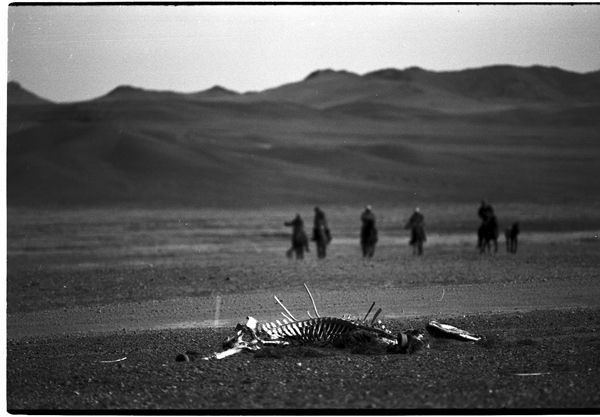 Life for herders on the steppe is hard enough without the toxic pollution and land-grabbing of |
In May 2013, Fire Nations' own investigator discovered epidemics of diseases; faceless animals, jawless animals; diseased internal organs; many abnormal births and birth defects. Prior to AREVA's arrival such things were unheard of. In August 2013, armed Fire Nation activists and local herders occupied AREVA's mining camp and stopped operations. AREVA resumed operations after Munkhbayar and other Fire Nation protestors were arrested September 16.
Fire Nation leaders and herders returned but were barred entry to the AREVA camp by nine-foot fences with triple-barbed wire overhangs and armed paramilitary guards: AREVA even refused entry to a state inspector.
Uranium exploration and radioactive contamination in Mongolia is not limited to the Dornogovi site in the Gobi desert. There are mine sites as close as 70 kilometers from the capital city.
"Given that everything related to uranium is kept 'state secret' we have little information about this threat to 60% of Mongolia's population, residing in Ulaanbaatar," says Sukhgerel Dugersuren, Executive Director of the Mongolian organization OT [Oyu Tolgoi] Watch.
|
- D. Tumurbaatar shoots a bow at Parliament after the April 2011 protest where 100 horse-riding herders' demonstrated in Sukhbaatar Square (city center, square in front of the Government House). The demonstrators requested enforcement of the environmental law by setting up 8 gers (felt tents ) on the square and calling for national referendum and collecting signatures. When the President and Prime Minister of Mongolia and Parliament Speaker ignored their request to meet, Mr Tumurbaatar conveyed his message by shooting an arrow.
The U.S. government and Japanese government apparently find Mongolia to be the best location for dumping their nuclear waste. Agreements [were] signed many years ago but there is no information disclosed about the actual status, no opportunity for local monitoring, no info on risks and how to be prepared for mitigation. We know that Japan is negotiating heavily." [6]
Oligarchs like Mr. Bold use media venues like National Overview just as the Western press is used by the U.S. Nuclear Regulatory Commission and nuclear corporations, always assuring the public that nuclear contaminations present 'no risk to the public', that 'radiation is safe, clean and green'. However, the media also knowingly collaborates in maintaining information whiteouts, keeping the public in the dark, upholding the cloak of secrecy and denial about the nuclear apocalypse and nuclear poisons and the threat to all life on earth.
"I think it is absolutely obvious that the U.S. and Japan plan to dump nuclear waste at Oyu Tolgoi," says a former USAID official who, like many people, is concerned about retaliation for speaking out. "Would China and Russia allow nuclear material to go by land via their territories? No. So, it has to arrive by air. Other than Ulaanbaatar, where does Mongolia have an airport that can handle heavy cargo carriers? Oyu Tolgoi. And where do we have enough holes in the ground to bury the waste? Oyu Tolgoi."
Following the 16 September 2013 protests in, the editor-in-chief of National Overview contacted Fire Nation members disingenuously claiming to want to present the activists' positions on the protest and the LLN and other national affairs: the editors and owners are known for dishonesty and double-standards (behaving much like editors and journalists of major Western media corporations).
"The image the government and media are trying to paint does not fit Tsetsegee Munkhbayar and his friends," said Erkhem Amarlin, founder of Golomt.org, a prominent educational web site and campaign. "[Munkhbayar and colleagues] are humble, poor, and, I am sure they know better than showing off an expensive WESTERN! luxury watch."
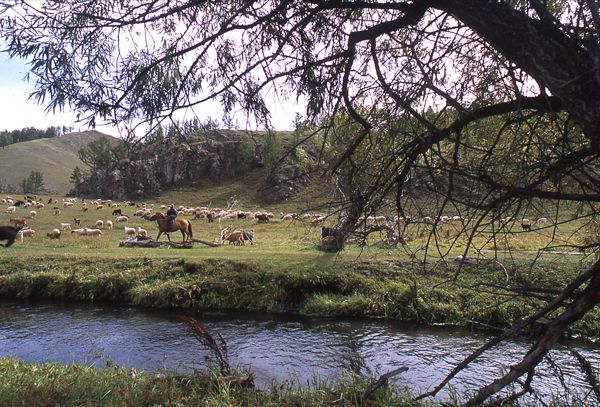 Pristine rivers in Mongolia have been diverted and polluted with cyanide and sulfuric acid, |
"Due to the media reports, for many in the Mongolian public the initial reaction was fear, and accusation of Munkhbayar and his companions." Ms. Amarlin investigated the facts and propaganda after the 21 September 2013 protests. "Others believe that the arrest was orchestrated by the government that had blamed the 'Long Named Law' for the recent weakening of the [Mongolian state currency] Tugrug -- which declined about 20% from June to September [2013]. The 'Long Named Law' was blamed for a drop in foreign investment. [7]
BLAME THE VICTIMS
Mongolian civil society leaders believe that the state currency was deliberately devalued to demonize non-government civil society organizations. After the currency fell, the media blamed the LLN for declining foreign investment. As the masses suffered increasing economic hardship, Mongolia's civil society coalitions were scapegoated. However, NGOs believe that the currency fluctuation was orchestrated by Mongolian elites with the help of foreign interests. Along come Munkhbayar and the other protestors, rifles in hand, and the media frames them as terrorists, further discrediting civil society in the minds of the masses.
The Western 'news' establishment (e.g. Associated Press, UPI, Agence France Press, TIME, Newsweek, New York Times, International Herald Tribune, Economist, Guardian, etc.) did not report on the 16 September 2013 protests: the press ignores such topics as conflicts between herders and miners; radioactive contamination from uranium mining; dispossession of sacred lands; or violence by paramilitary thugs hired by mining companies. When it does cover them, it casts the conflict in light favorable to capitalism.
Bloomberg Business News is the only Western media to report on the 16 September 2013 protest, and this a short clip that merely parroted Mongolia's state-owned Montsame News Agency
"Mongolia put its parliament building on lockdown after shots were fired during a protest outside," wrote Michael Kahn. "The protestors brandished weapons and said they would resort to armed conflict if the regulations were changed... One of the groups involved in today's protest [Fire Nation]... has used violence in the past..." The egregious violence used by foreign mining companies, the toxic pollution, the diversion of whole rivers, or the destruction of Mongolian herders' lives, culture and futures, is (typically) never mentioned. [8]
In one of the (unsigned) English language stories produced by the Mongolian propaganda system, the supposed 'facts' of the protest were presented as absolutes, no matter that they were wrong, that they were exaggerations, and that they were framed to demonize the protestors and validate the punishments doled out by the Mongolian courts.
"While Parliament was discussing the amendment into [sic] the [LLN] law the group [protestors] initiated a bomb scare and fired a shot opposing the amendment of the law to ban mineral exploration and exploitation in river and forest basins." [9]
Once such stories are published, the damage of sowing public apathy and mistrust is done: undoing it is much harder.
On 21 January 2014, the same day the six protestors were sentenced, the parliament passed (at 53%) amendments to the taxation law that reduced taxation for gold mining companies from 5% to 2.5%.
The 21 January 2014 trial of Munkhbayar and the others concluded quickly over less than two days. Initially announced in December as open to public, it was postponed and moved to Correction Facility #461 -- a remote location with no public transportation. Some family members, colleagues and some press were barred from the courtroom. Seven men were tried, two were released due to 'lack of evidence' -- another ploy to bring the appearance of legitimacy to the trial.
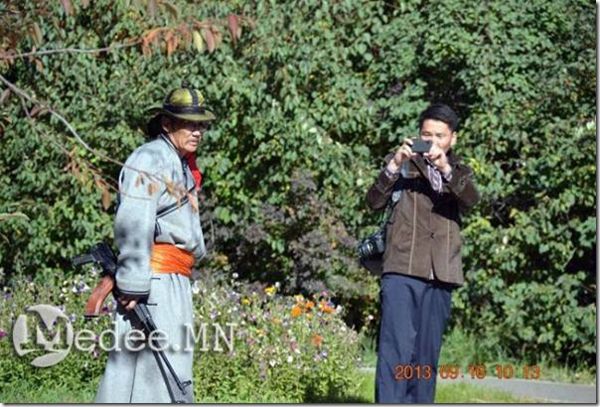 Ms. Gantulga (with camera) of UMMRL was arrested twice since 16 September 2013 for |
For example, at the trial it was confirmed that the weapons of the protestors were either unloaded or loaded with (harmless) blanks: only Ts. Munkhbayar and D. Tumurbaatar's guns were loaded. Statements by the men and their lawyers that the guns were harmless were ignored. However, experts announced in trial that the ammunition was inoperable: there were no explosive charges, rendering the 'loaded' rifles harmless.
THE SHOT HEARD ROUND THE WORLD
It was confirmed at trial that none of the six men fired the single shot heard round Parliament. Evidence suggests that state security agents fired the shot as a pretext to arrest and neutralize Mongolia's most outspoken civil society leaders. The court refused to question state security agents and refused to investigate who had fired the shot.
A hand grenade reportedly recovered by police outside the Central Tower was deemed harmless upon expert review. The person who reportedly supplied it to Ts. Munkhbayar, M. Munkhbold (the stroke victim), confessed that it 'burned' but could never explode: he was sentenced to years. Sources in Mongolia say hand grenades allegedly found on some protestors were also disabled, hence harmless.
The questions of the explosives attributed to the protestors and splashed all over the public mind by the mass media -- e.g. questions of their origins, nature, possession, distribution and planting of -- were never addressed at trial. The court did not address or discuss the explosives.
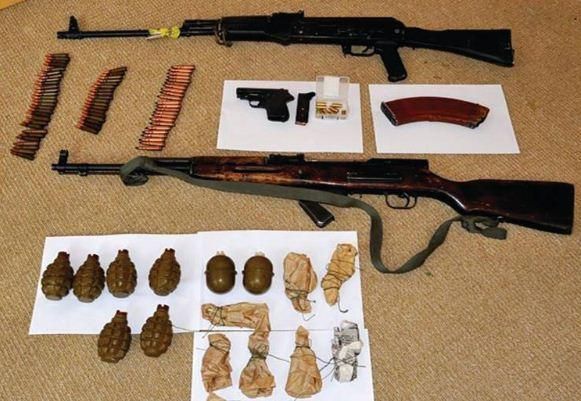 Photos produced by the state security apparatus show weapons, ammunition and explosives |
The state security apparatus in Mongolia has become increasingly repressive. For example, the son of one of Ts. Munkhbayar's colleagues was killed on 1 July 2008, when thousands of people protested the rigged national elections: police responded with bullets, arrests, tortures, disappearances and secret trials. Five people were killed, the shooters were not identified, the police officers that gave the command were charged 3-5 years. The Western press produced superficial reports, but post-election state-orchestrated violence was in whiteout. [10]
Corruption prevails in proportion to the obscene profits that have accompanied the flood of foreign currency, unbridled urban development, and rapacious mining, since Mongolia's transition from a 'communist' to 'democratic' country in the early 1990s. Corrupt Mongolian elites, Western currency speculators, hedge fund and investment banks, and foreign NGOs have all profited from the largesse.
The former Chairman of the Mongolian People's Revolutionary Party, for example, Sanjaagiin Bayar, was a key actor behind the Oyu Tolgoi mining deal signed 7 October 2009 after years of scandal. He became Prime Minister on 22 November 2007 and resigned in 2009 citing 'health issues'. On 29 November 2007 Mr. Bayar purchased a Manhattan (NY, USA) apartment for $US 895,000; he paid some $US 16,000 in 2008 property taxes, rented the suite for $US 4950 a month; and as of January 2014 had it listed for sale at $US 1,195,000. S. Bayar (59) currently lives in Bellevue, Washington (USA) with his second wife and family.
Mongolia's state security apparatus ensures protections for racketeering, bribery, illegal search and seizure, trafficking of women and children, slave laborer, and other 'black market' activities and international crimes. The system of incentives motivates police to 'solve' crimes by forced confessions, tampering with and planting evidence, and other means.
Following the 16 September 2013 protests, state security agents began targeting civil society members, following people, searching homes, and members of the Fire Nation coalition believe that their cellphones are tapped.
A lawyer for defendant D. Tumurbaatar's revealed that his client's home was searched after police called his daughter, lied to her about a non-existent message from him, and then arrested her for alleged drunkenness. After the daughter (who claims sobriety) was locked in the drunk-tank, police searched and 'discovered' explosives. Police used the pretext of calling the daughter to eliminate any witnesses to their planting the explosives -- which they then produced and displayed at a press conference.
Soon after Ts. Munkhbayar's arrest, a Mongolian director of the gold-mining company AUM, Mr. Ts. Myagmardorj, suddenly announced that Ts. Munkhbayar had blackmailed and extorted some 67 million Tugrugs (~ $US 39,000) from him. The media ran with story, interviewing Mr. Myagmardorj all over the place, presenting him on Eagle TV -- again owned by MP and Foreign Minister Lu. Bold -- where he recounted his victimhood. Claiming losses of millions of Tugrugs, he produced receipts (some very dubious) to prove his allegations. Mr. Myagmardorj then issued a statement saying that Ts. Munkhbayar had in the spring of 2013 petitioned him for one billion Tugrugs (~ $US 700,000 at the time of the alleged extortion) to be used to mount a coup d'état.
Mr. Myagmardorj's accusations deeply affected public opinion. The public had already been led to distrust environmental NGOs, having been bombarded with duplicitous propaganda portraying them as lazy counterfeits who expect easy money from foreign donors, and as extortionists who blackmail mining companies. In a similar case several years ago, Ts. Munkhbayar was accused of extorting money from the owner of a mining company; he was exonerated in court, but the media ran few stories declaring his innocence, against the many that had proclaimed his guilt. The local police chief, apparently, was present when the donor personally handed the money to Ts. Munkhbayar.
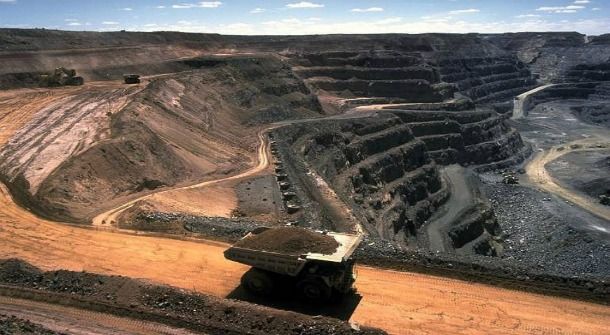 Rio Tinto & Ivanhoe Mines: The Oyu Tolgoi open pit in the Gobi desert. |
When Ts. Munkhbayar appeared in court to answer the more recent charges, his accuser, Mr. Myagmardorj, failed to appear at the trial. Defense lawyers were able to prove that Myagmardorj willingly donated some and loaned some of the money: witnesses testified to the true facts, and a video was shown of the meeting where Mr. Myagmardorj declared his donation to the Rivers Movement -- claiming his adamant support of their activities.
"As you see, full-time environmentalists in Mongolia are on their own, they don't have any funding," says Erkhem Amarlin. "They appreciate donations, even those from mining company directors, but they never know when they will be stabbed in the back."
STRUCTURAL VIOLENCE RENDERED INVISIBLE
Mining companies have manipulated, coerced and threatened nomadic herders whose traditional lands are being taken for mining operations and destroyed. Herders have been forced on short notice to relocate to less fertile locations, and the dispossession and destruction of their traditional habitats insures the end of their livelihoods.
"The herders were forced to move to inferior locations without adequate time to select spots that would protect their animals from harsh winter storms," reports Sukhgerel Dugersuren of OT Watch.
"Mongolia has some of the world's largest undeveloped mineral reserves, including gold, uranium, coal and copper," TIME reported, in a short 28 January 2014 clip about the jailing of Ts. Munkhbayar. TIME then paints otherwise rapacious mining corporations as cooperative, respectful, even law-abiding. "
Thanks to the efforts by Munkhbayar and the alliance of environmentalists that he set up, mining companies agreed to limit their pollution of rivers as well as the displacement of local herders." [11]
Here's what's wrong with that last statement: [a] mining companies rarely agree to anything that affects profit margins; [b] all public statements they make are meant to influence public opinion; [c] press releases often are run almost verbatim in Western media venues; [d] press statements are generally deceptive, at best, and usually they are blatant lies; [e] mining companies do NOT 'limit the pollution of rivers'; [f] not anywhere: not in the USA, or Papua New Guinea or Congo or Mongolia; [g] the statement (concept) is meaningless: they are leeching deadly cyanide and sulfuric acid into the pristine rivers of rural Mongolia; [h] in any case: mining operations are responsible for diverting and drying up entire rivers; [i] and they do not, in any way, 'limit the displacement of local herders' (emphasis added).
The Law with the Long Name was never implemented, even after its adoption. Mining companies have ignored it, and there has been no enforcement by government. The TIME statement is a bundle of absolute lies sifted in with some truth (about Munkhbayar).
Even more revealing is the short closing paragraph, where the purpose of the TIME propaganda becomes clear: "In September, the [Mongolia] government agreed to a partnership with French company AREVA to revive uranium exploration in the Gobi Desert, which activists claim has led to death and deformities among livestock." [12]
TIME cares nothing at all about 'death and deformities among livestock': the piece is anti-France, and the last paragraph is designed to manipulate Western pubic opinion against French nuclear corporations, and in favor of U.S. (and Canadian) nuclear corporations.
Directors of non-Mongolian mining companies now plundering Mongolia and manipulating the government include U.S., Canadian, Australian, European and South African executives with current or former ties to: defense and intelligence sectors; state departments; and Wall Street banks. Many directors have long pedigrees with corporations responsible for genocide and ecocide in Australia, Argentina, Burma, Canada, Chile, Congo, Haiti, Indonesia or the United States.
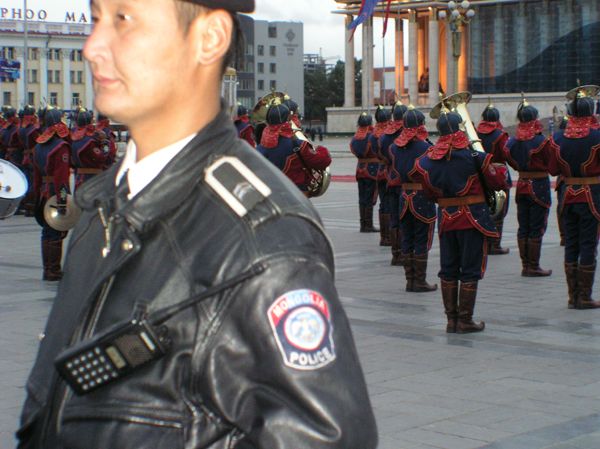 Police and other state security and intelligence agents have become increasingly repressive. |
The British Royal Family are shareholders in the international mining conglomerate Rio Tinto, which has corrupted Mongolian officials to turn a blind eye to pollution and human rights violations. For example, Article 25.2 of the 'Law on Budget' stipulates that a state budget-funded organization/agency may receive outside donations. This clause allowed Rio Tinto to 'donate' money to the President's office and donate new Toyota Landcruisers to the Specialized Inspection General Authority and to the local parliament (responsible for land decisions) in exchange for favorable decisions. The Inspection Authority then issued 'Order #57' a very benign sounding title for an order ostensibly aimed at improving internal efficiency, but which resulted in the elimination of the mandate to inspect strategic mining projects for the inspector local to Rio Tinto's concession.
Rio Tinto has threatened lawsuits against Mongolian civil society leaders who speak out.
The executives of mining corporations cycle through the revolving doors between corporate and government sectors. Directors are former U.S./Canadian/Australian senators, ambassadors, USAID officials, DFID (UK) officials, CIDA (Canada0 officials and British Lords. Some shady corporations have close ties to former U.S. presidents and work with many other nasty dictatorships, and are closely linked to mercenary companies and arms dealers. [13]
Mongolian government officials also sit on some foreign mining boards. These corporations all use the top auditing agencies to hide corrupt practices (tax evasion, tax havens, loopholes, transfer pricing, etc.), and they use the most scandalous public relations companies (e.g. Britain's Bell Pottinger) to put a happy face on exploitation and promote such frauds as 'sustainable development' and 'a more secure future for the people of Mongolia'.
Genie Energy is another notable extractive industries firm exploiting oil shale in Mongolia. A US/Israeli corporation, Genie's management includes a former Israeli parliamentarian (Knesset) and current Brigadier General of the Israeli Defense Forces. Directors of Genie Energy's subsidiary, Israeli Energy Initiatives, include another IDF Brigadier General. [14]
Until recently, Dick Cheney was another Genie director. [15]
The North America-Mongolia Business Council, Inc. (NAMBIC), whose officers and directors include Canada's first Ambassador to Mongolia, former USAID officials, and a former U.S. Ambassador to Mongolia (2003-2006), drives World Bank and U.S. Embassy policies and actions in Mongolia. [16]
To circumvent international conventions on indigenous people's rights, and the UN Convention on the Prevention and Punishment of Genocide, the World Bank and IFC decided that nomadic herders in Mongolia do not qualify as 'land-based mobile peoples' to be protected under their Indigenous Peoples
"We do not need gold or money, but water and land to live," declared L. Battsengel, director of the herder organization Gobi Soil, formed to fight against the destruction of the herders' way of life by large-scale mining and related infrastructure development.
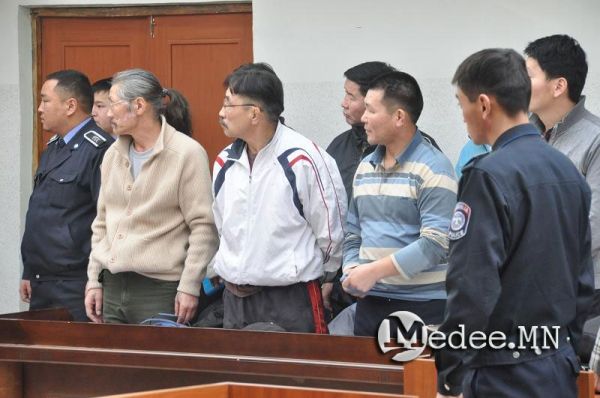 The six environmental leaders accepted their sentences in court with dignity and calm. Ts. |
In August 2012, the former president Nambar Enkhbayar was sentenced to four years in jail for defrauding the People. The New York Times covered [sic] this story: on 3 August 2012 they reprinted a 53-word summary provided by China's national news service Xinhua.
On 27 January 2014, some 35 nonprofit organizations in Mongolia organized a press conference demanding the release Ts. Munkhbayar and the others. Family and Fire Nation members collected over 1000 signatures after seven hours in sub-zero weather.
Earthworks, a U.S.-based non-profit pressure organization, created a petition for Munkhbayar's release, but the organization forgets about Munkhbayar's colleagues, the dedicated civil society leaders who have helped create the legend of Tsetsegee Munkhbayar, and whose safety must also be insured and release must also be won.
ETHNOCIDE IS GENOCIDE
Many researchers, human rights workers, journalists and scholars deem the ways in which indigenous peoples have been dealt with in the 20th century to be genocide. Others limit the characterization to ethnocide. Others deny the scale or nature or extent of the violence, and dismiss the genocide label.
"Indigenous groups have had difficulty getting redress for crimes committed against them, and they have often been treated negatively by courts when they have been charged with illegal activities," wrote two renowned genocide experts. "Often, the sentences they receive are more severe than those meted out to non-indigenous individuals." [17]
These scholars' assessment fits the case of Ts. Munkhbayar and colleagues.
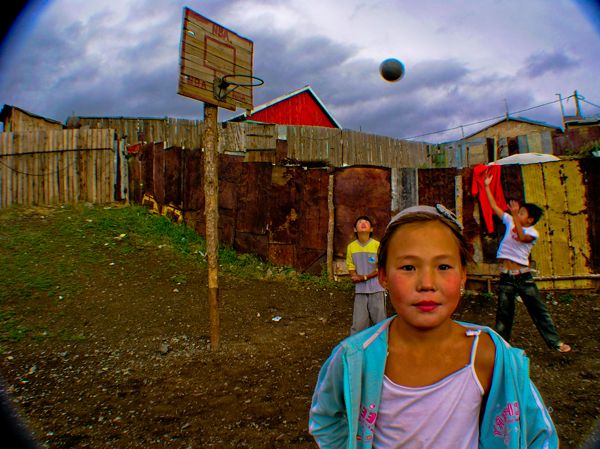 More and more nomads are being forced to the margins of existence, dispossessed of their |
Many 'genocide experts' narrowly limit the Genocide Convention to 'acts committed with intent to destroy [defined] groups in whole or in part'. Others extend the genocide formulation to include the intentional prevention of ethnic groups from practicing traditional customs; forced resettlement; denial of access to food relief, health assistance, and development funds; and destruction of habitats utilized by indigenous populations. [18]
1. Indigenous peoples and individuals have the right not to be subjected to forced assimilation or destruction of their culture.2. States shall provide effective mechanisms for prevention of, and redress for:
Seems that all of the above can be applied to the case of indigenous herders in Mongolia (and this is only Article 8 of 46 articles) and they would be applied, if the system were just, and the United Nations (International Criminal Court, ICTY, ICTR, Supreme Court, etc.) was for real.
- (a) Any action which has the aim or effect of depriving them
- of their integrity as distinct peoples, or of their cultural values
- or ethnic identities;
- (b) Any action which has the aim or effect of dispossessing
- them of their lands, territories or resources;
- (c) Any form of forced population transfer which has the aim
- or effect of violating or undermining any of their rights;
- (d) Any form of forced assimilation or integration;
- (e) Any form of propaganda designed to promote or incite
- racial or ethnic discrimination directed against them.
The terminology 'violence' applied to the actions Ts. Munkhbayar and other Fire Nation activists turns the problem of perpetrator-versus-victim upside down. It is a rationalization created by powerful elites, and Westerners have bought into such rationalizations, and we go along with them, because they enable us to harbor false beliefs and a collective insanity about our own innocence, goodness and charity.
In the topsy-turvy equation of perpetrator-versus-victim, the Mongol herders cornered by capitalism, left landless and homeless, adrift in a crisis of identity and purpose, watching from ger cities and behind fences and jail cells as all they ever knew and loved and all that is sacred to them is destroyed, are portrayed as the perpetrators (of violence). Meanwhile, our predatory Western executives and our predatory corporations, allied with a comprador class of Mongolian elite collaborators, who are the actual perpetrators of extreme violence, are portrayed as the victims (of it).
These definitions and realities occur by default and assumption and without discussion.
Tsetsegee Munkhbayar and his colleagues have the right to protect their culture, the right to protect themselves, and the right to protect their people...
And yet Westerners regard with shock and displeasure the actions of Tsetsegee Munkhbayar and friends, who had the audacity to show up at the Mongolian Parliament with weapons in their hands.
"Not for me that armed protest, that is violence," I can hear the Westerner saying, "and I am an adherent of non-violence, of Satyagraha, I believe peace is the way."
But inside themselves (ourselves), it is really an internalized terror that the Westerner has to deal with, a terror that someone somewhere might come forth and confront them (us) and all of their (our) privileges and affluence and righteousness and decadence and non-violent violence, and our higher moral values...
Someone like Tsetsegee Munkhbayar, who is willing to stand up and fight for the survival of an entire people, his people, to fight for his way of life, and to protect and honor the sacred Mongol land by giving his own life.
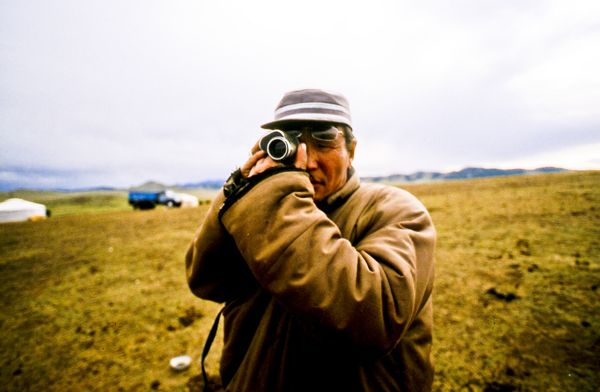 Absent serious protections for the invading foreign capitalist hordes, the future for Mongol |
NOTES:
Written by: keith harmon snow
Photography Credits: keith harmon snow
 |
 |
 |
Articles for February 5, 2014 | Articles for February 6, 2014 | Articles for February 7, 2014





googlec507860f6901db00.html
Terms of Service | Privacy Policy
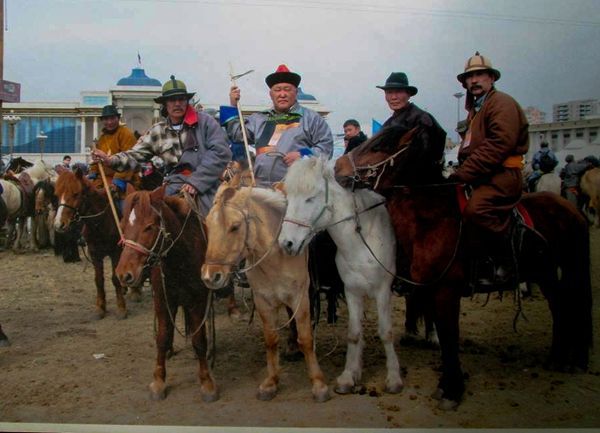
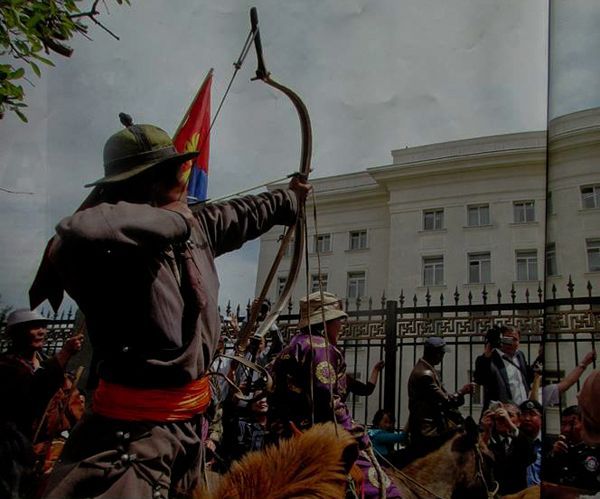
All comments and messages are approved by people and self promotional links or unacceptable comments are denied.
[Return to Top]
©2025 Salem-News.com. All opinions expressed in this article are those of the author and do not necessarily reflect those of Salem-News.com.